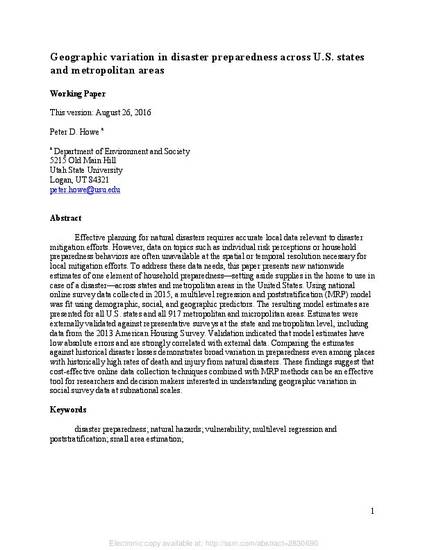
Unpublished Paper
Geographic Variation in Disaster Preparedness Across U.S. States and Metropolitan Areas
(2016)
Abstract
Effective planning for natural disasters requires accurate local data relevant to disaster mitigation efforts. However, data on topics such as individual risk perceptions or household preparedness behaviors are often unavailable at the spatial or temporal resolution necessary for local mitigation efforts. To address these data needs, this paper presents new nationwide estimates of one element of household preparedness — setting aside supplies in the home to use in case of a disaster — across states and metropolitan areas in the United States. Using national online survey data collected in 2015, a multilevel regression and poststratification (MRP) model was fit using demographic, social, and geographic predictors. The resulting model estimates are presented for all U.S. states and all 917 metropolitan and micropolitan areas. Estimates were externally validated against representative surveys at the state and metropolitan level, including data from the 2013 American Housing Survey. Validation indicated that model estimates have low absolute errors and are strongly correlated with external data. Comparing the estimates against historical disaster losses demonstrates broad variation in preparedness even among places with historically high rates of death and injury from natural disasters. These findings suggest that cost-effective online data collection techniques combined with MRP methods can be an effective tool for researchers and decision makers interested in understanding geographic variation in social survey data at subnational scales.
Disciplines
Publication Date
2016
Citation Information
Howe, Peter D, Geographic Variation in Disaster Preparedness Across U.S. States and Metropolitan Areas (August 26, 2016). Available at SSRN: https://ssrn.com/abstract=2830690
